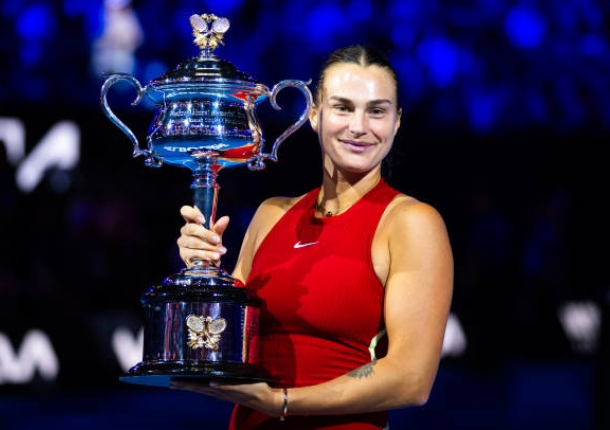
By Chris Oddo | @TheFanChild | Saturday January 27, 2024
Aryna Sabalenka didn’t just rise to the challenge of defending her title at this year’s Australian Open – she obliterated it.
And the fact that she did so is a testament to her constant evolution as a player and as a competitive being. The journey has been long, the struggles have been manifold, the quest to master her demons well-documented.
Now the dust settles in Melbourne and we see the rest of the field trampled in the wake of a confident stampede that saw Sabalenka hardly tested as she became just the fifth woman to win an Australian Open without dropping a set since 2000.
Struggles, off-court and on, have proven to be mere speed bumps to an athlete who is preternaturally gifted for the slow climb. Sabalenka is relentless when it comes to embracing the hard look in the mirror, the hard yards and the even harder setbacks. It seems that each time we think she is in danger of slipping back into bad habits, we find that it is the rest of the field who is in danger of feeling her wrath.
For Sabalenka, it has been a process, to say the least.
“It takes me so much time to kind of like become who I am right now on court, to have this control [over] myself,” she told reporter after her 6-3, 6-2 takedown or Zheng Qinwen in Saturday’s women’s final in Melbourne. “And to understand myself better. It's been a long journey.”
At 25 Sabalenka, a player whose name was once synonymous with mental frailty, combustibility and an affinity for imploding under pressure, has built a fortress around her game, and she put this new steadfast, if still evolving, version of herself on display over the course of the Aussie fortnight.
Gone were the double faults that plagued her a few seasons ago (there were zero in the final). Gone was the capacity for self-sabotage in the big moments (though to be fair she played so well there was really only one tough moment in all of her seven matches!) and in place was an unshakable, forceful player, guided by self-belief.
To put it another way: Sabalenka is 30-3 at the majors since the start of 2023, and has reached the final of all three hard court majors she has played, and won two. This is a woman who won her maiden major in 2023, and rather than rest on her laurels, she declared her next big goal: to chase down Iga Swiatek for the No.1 ranking.
That mission impossible was accomplished late last year, and even though she handed the top ranking back to Swiatek at year’s end, her desire to continue proving herself at the majors produced immediate dividends.
What makes Sabalenka such a steady force? She has made peace with the pain, and found a path through disappointment to better tennis. It is this high tolerance, this embrace of the low moment as the teachable moment, that has guided her consistently higher in her career.
She’s a two-time major champion now, and a certain Hall of Famer. All before her 26th birthday.
“Actually it's been in my mind that I didn't want to be that player who [won a major] and then disappeared. I just wanted to show that I'm able to be consistently there and I'm able to win another one,” she said. “I really hope that [I can one day win] more than two right now, but for me it was really important. That's why, no matter what the result, win or lose, we are always working hard, we are always looking for things to improve in my game.”
For Sabalenka, much like Jannik Sinner on the men’s side, the modus operandi is: turn over every rock, never stop improving, and good things will happen.
“It's all about the process and making sure that, about the discipline, make sure that you're always there, you always show up, and you always work hard.”
One could say that Sabalenka has a big advantage over the rest of the field, being such a colossal striker of the ball, with such immense power, but those who have watched her stumble, get back up, stumble again, and rise to higher heights know that her success hasn’t come naturally.
She has done it the old fashioned way. She has done it in a way that very few are willing to do. She has outworked her bad habits, stared down her demons, wiped away her tears and after each tennis tragedy, emerged as a stronger version of herself.
If she stumbles again – and let’s face it, this is the cutthroat world of women’s tennis, she will – not to worry. Sabalenka has created the perfect blueprint for success, in her mind, in her heart and in her body.
Deep down, she knows she’s not out of the woods, and that knowledge should serve her will into the future.
“I actually felt after last year it's going to help me to be more free and not care about things, and blah, blah, blah,” she told reporters, referring to finally winning her maiden major title last year in Melbourne. “But not really. You still feel the same. You still want it badly and you are still working very hard for it, and you still have to show up and fight for it and show your best level.
“Before I was watching all these champions crying after each slam, I was, like, ‘Come on, you've done it, like, 15 times. Why are you still crying?’ Right now, I didn't even get to that point, but I feel like I understand why they are still crying. Because every time, the same pressure, the same expectations. You want it the same way. So it's always emotional.”